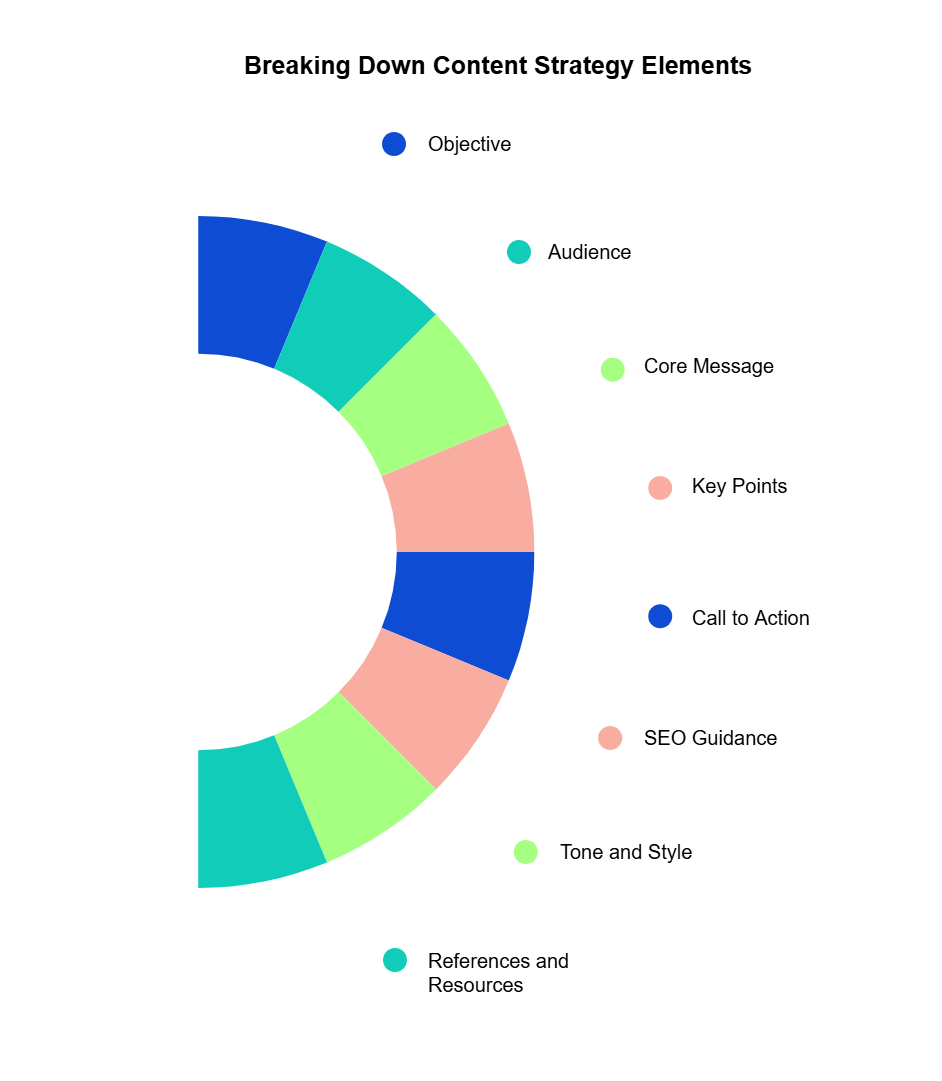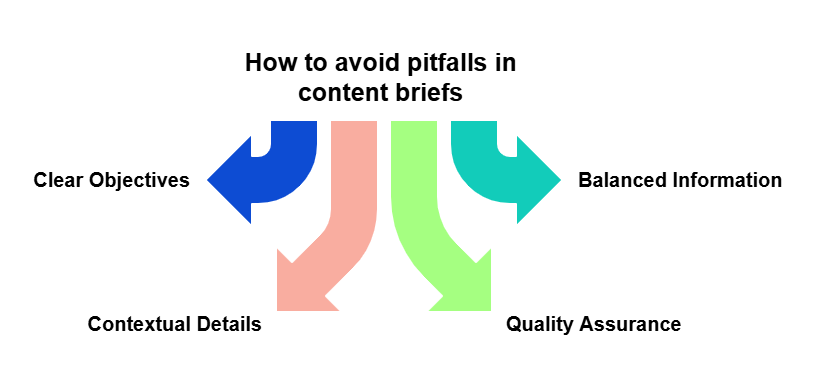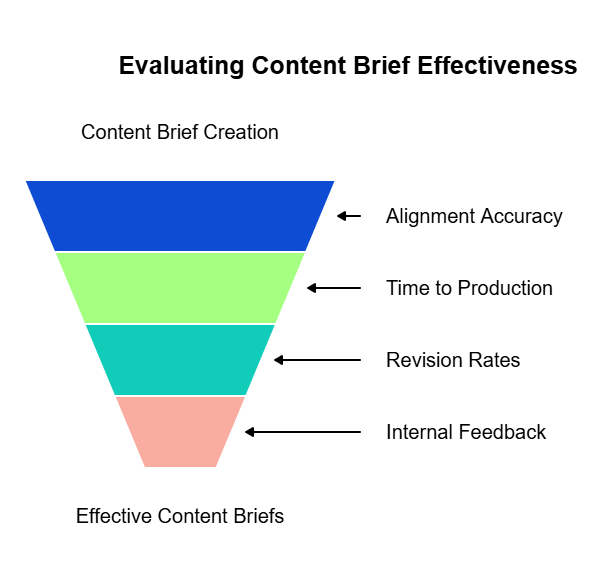Every marketing team wants to create content that drives the pipeline, supports campaigns, and meshes with organization’s broader goals.
But too often, teams jump straight into execution without laying the groundwork. The result is content that’s disconnected from tstrategy.
And if your content fails to serve your strategy, it will never support your goals.
That’s where content briefs come in.
A good content brief connects your content marketing strategy to your creative output. It gives your writers and designers more than just a topic: It gives them purpose, clarity, and direction.
With clear messaging, smart storytelling, audience targeting, and campaign context baked in from the start, briefs are critical part of building your brand and driving conversions.
And if you’re working with complex teams and timelines (and time zones!), content briefs can reduce the number of drafts a team has to wrangle, improve collaboration, and keep everything moving in the right direction.
Content briefs format
If you’re in charge of generating briefs, it’s your job to cut out ambiguity, remove guesswork, and provide clear information that ties directly back to your goals. A strong content brief should give creators everything they need in one place.
At a minimum, every content brief should include some core elements.
Objective: What is this piece of content trying to achieve? Be specific. Should it drive traffic, support a campaign, or improve SEO for a key term? The objective should be tied to your larger marketing goals.
Audience: Who are we talking to? Go beyond general personas (a.k.a. Ideal Customer Profiles or ICPs). Include relevant insights, pain points, and anything the creator should know about what the audience values.
Core message: What is the main idea or takeaway? This should be sharp and clear. If someone skims the content, this is what you want them to remember.
Key points: What must be included to support the core message? Outline the structure or major talking points. This keeps content focused and aligned with your strategy.
Call to action: What should the reader do next? Whether it's filling out a form, downloading something, or simply understanding a concept, make this explicit.
SEO guidance: If applicable, include SEO best practices, such as relevant keywords, internal links, and metadata requirements. This helps optimize content without losing sight of the strategy.
Tone and style: Link to your brand voice guidelines or give a few sentences on how this piece should feel. Should it sound technical? Conversational? Authoritative?
References and resources: Include background materials, research links, and examples. This speeds up content creation and reduces back-and-forth.

Your content brief doesn’t need to be long or fancy. A Google Doc or Word file is usually fine. Don’t worry about dressing it up with formatting or design elements.
The specific format of content briefs will vary based on your needs. Review some content brief templates to get an idea of what you need.
From strategy to brief
The purpose of a content brief is to put strategy into actionable terms. This means every time you create a brief, you should start by reviewing your marketing plan.
What campaign are you supporting? What message are you reinforcing? What’s the business objective? These questions shape everything that follows.
Start by identifying the strategic theme, whether it’s brand awareness, lead generation, product education, or something else. Then build your brief around that theme. Define the message, the audience, the channels, and the call to action in direct relation to that goal.
For example, imagine that your team is launching a campaign to promote a new enterprise compliance tool. The strategy is focused on lead generation for enterprise IT leaders.
In this case, your brief should reflect that: the audience isn’t general marketers, it’s directors of IT at large organizations with compliance mandates. The content should highlight practical benefits tied to legal risk and ROI, not just product features. This level of specificity helps your creators focus the message and deliver content that supports the campaign’s goals.
Don’t keep your briefs in silos. Store them in a shared space where other teams can weigh in if that would be valuable. A campaign manager might add context. An SEO specialist might layer in keyword guidance. This kind of collaboration makes your briefs stronger and keeps everyone aligned.
When your briefs are built from strategy and accessible across teams, they become more than a tool for content production. They become the framework for executing campaigns with consistency, focus, and measurable impact.
Best practices for content briefs
Effective content briefs don't happen by accident. Here are the best practices you can apply immediately to ensure your briefs deliver clarity, actionable guidance, and measurable impact.
1. Be clear and direct
Skip vague language. Clearly spell out your objectives, messaging, and requirements. The goal is to reduce guesswork, not create more questions.
Furthermore, use clear headlines, formatting, and structure. Make sure your brief is scannable. Bold or highlight key points so critical information doesn’t get missed.
2. Align goals explicitly
Tie every brief directly to a business objective or strategic priority. If the creator can’t easily identify how their content supports the strategy, your brief isn’t clear enough.
3. Keep it concise but thorough
Provide enough context for creators to understand the task fully. Bullet points and checklists are helpful here. Avoid lengthy paragraphs or excessive detail that might overwhelm or confuse the creator.
4. Inspire, don’t prescribe
Give creators enough space to stretch their legs. Define guardrails, but don’t script every word. A great brief inspires creativity while still driving the intended outcome.
5. Provide real-world examples
Include samples of similar successful content or competitor benchmarks. This gives your creators clarity on your expectations and sets a quality standard to aim for.
6. Make it actionable
Every section should provide clear direction on next steps. If creators read your brief and still don’t know where to start, you've missed the mark.
7. Avoid certain pitfalls
Here’s what typically trips up both brief creators and writers:
Unclear or generic objectives: Ambiguity leads to confusion and rework.
Too much or too little information: Both extremes hinder creators. Find a balance.
Lack of context: Don’t assume creators know every campaign detail. Provide the context they need. This often means educating your creators on the broader strategy.
Lack of review or quality assurance: Always double-check briefs for clarity and alignment with the strategy.

Content briefs for marketing campaigns
Writers and designers use briefs to create specific pieces of content, but a brief can also be used to outline the general layout of a new marketing campaign. A good brief can influence whether your campaign resonates with your audience, achieves your goals, and provides measurable results.
Suppose you’re planning a campaign to celebrate the inclusion of a hot new designer in your summer furniture line. That kind of campaign would involve multiple forms of content, such as social media posts, blog articles, landing pages, emails, or ads
Managing all of that content requires a parent brief so the individual pieces don’t stray too far from the campaign’s objective. Individual teams can use the marketing brief to inform their content-specific briefs.
Essentials components of briefs for marketing campaigns
These are the must-haves for just about any brief:
Campaign goal: Clearly define the primary objective of the overall campaign. This might be lead generation, brand awareness, product education, sales, etc.
Audience segment: Specify the exact audience the content will target, including insights about their motivations and behaviors. Campaigns rarely target the entire customer base.
Core campaign message: Articulate the overarching message or key takeaway you want the audience to remember.
Distribution channels: Explain where and how the content will be used. A blog post requires different considerations than an Instagram story.
Specific CTAs: Indicate the next step or conversion action you want the audience to take. There may be a few possible conversions or a funnel of steps.
Visual and brand guidelines: Reference specific design or branding requirements for the campaign. Link to guidelines or relevant examples.
Measurement plan: Outline the KPIs or metrics used to gauge the effectiveness of the campaign as a whole and the individual marketing assets.
Storytelling in your content briefs
Brand storytelling connects people to your company’s purpose, values, and personality. But communicating your narrative across multiple channels and content types is challenging.
Fortunately, you can infuse this kind of storytelling into your briefs. It helps your team produce cohesive, memorable content that supports brand recognition and trust.
A brand storytelling brief ensures every creator understands how their content should align with and reinforce your brand narrative.
Elements that add storytelling to your brief
Narrative objective: What aspect of your brand story should this piece reinforce? For example, highlighting sustainability, innovation, or customer-centric values.
Audience connection: How should the story resonate emotionally or intellectually with your target audience? Include insights about the audience’s values or desires to strengthen the connection.
Brand messaging pillars: Clearly outline which elements of your core messaging the content should address. Provide specifics, not vague statements.
Tone and voice: Reinforce your brand personality. Clearly state the desired tone (inspirational, educational, humorous, etc.) and reference your brand’s style guidelines.
Story arc or structure: Define the narrative flow, even briefly. Include key points that set up context, address conflict, and resolve clearly, reinforcing your brand’s core identity.
Examples or benchmarks: Provide successful examples from your own brand or others. These help creators visualize expectations and execution.
It may seem like you’re doing a lot of work for the creator, but that isn’t the case. Give the writer or designer freedom to work your brand’s story into the content, but use the brief to lay out your expectations. This will reinforce your brand’s unique identity.
Measuring the impact of content briefs
Great content briefs are strategic tools, but to truly prove their worth, you need to measure their impact. How do they affect content quality and campaign success? How well do they influence your greater business outcomes?
Answering these questions will help you improve your briefs and, ultimately, your overall marketing campaigns.
Methods for evaluating content briefs
Track these metrics to gauge if your briefs are hitting the mark:
Alignment accuracy: Review content drafts against briefs. How often does content closely match your original intent without significant revisions?
Time to production: Compare content creation timelines with and without briefs. Good briefs usually mean fewer revisions and a quicker turnaround.
Revision rates: Measure how many rounds of edits content needs. Fewer revisions indicate clearer briefs and better alignment.
Internal feedback scores: Regularly ask your creators about the helpfulness and clarity of the briefs. Do they help? Do they get in the way?

KPIs to assess brief impact
Tie your brief assessments directly to campaign outcomes using some simple KPIs.
Content engagement: Track increases in traffic, pageviews, bounce rates, and dwell time. Improved engagement often indicates content is clearer and better targeted.
Conversion rates: Measure how effectively content drives actions like form submissions, downloads, or purchases. Clear, strategic briefs lead to stronger CTAs and better results.
SEO performance: Monitor ranking improvements for target keywords when SEO guidance is explicit in briefs.
Audience sentiment and recall: Use surveys or brand-tracking tools to assess if your storytelling content is effectively reinforcing your brand narrative.
ROI of your content briefs
The final question you have to ask yourself is if this is all worth your time.
First, consider your cost efficiency. How much does it cost you or your team to produce strong content briefs? Do your briefs save time for your creators? If so, what is that savings worth?
Next, try to calculate your total return. How much does your content earn? How much of that revenue can be attributed to your briefs?
Finally, compare the ROI of your content with briefs against your content without briefs. It may be hard to boil this down to actual dollars, but you may be able to determine how it affects the goals of your broader campaigns or marketing strategy (e.g. traffic, leads, upsells, etc.).
Build your strategic bridges
Your content briefs are strategic assets that bridge your marketing vision to your content.
When your briefs are clear and structured, your creators know just what to make to serve your goals. The output is higher quality and everything is produced faster.
Creating briefs may seem like adding another step to your already overloaded marketing process, but they actually offer agility and speed as your team gets used to them.
Bottom line: Great marketing starts with great briefs. Invest in getting them and your marketing outcomes will follow.
And if you need proof, know that this article started with a very thorough brief that was created with MarketMuse’s brief generator. From there, it went through just one round of light editing and it was ready to go.
Nice, eh?

